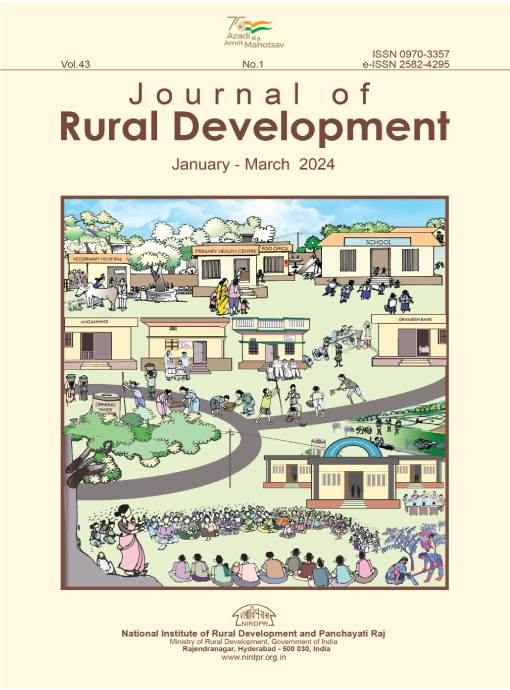The Riddles of Democracy: Election and the Reproduction of Dominance in a South Bihar Panchayat
DOI:
https://doi.org/10.25175/jrd/2023/v43/i1/173098Keywords:
Democracy, Panchayat Elections, Bihar, India.Abstract
The introduction of universal adult suffrage, operation of market forces, and measures taken by the state to include politically marginalised sections of population in the power structure have considerably loosened the grip of the dominant castes over the electoral system. However, election results from the local to the national level show that in the open (unreserved) constituencies, the electoral process continues to revolve around a few dominant castes. The paper, a study of a panchayat in south Bihar, brings out the mechanism through which the dominant castes retain their electoral dominance in Panchayati Raj Institutions, even when they are a numerical minority. It suggests that, firstly, more than the numerical strength of a caste, it is the caste composition of a village that plays a decisive role in who gets what where, and, secondly, without reservation, the weaker sections of population do not have much chance to get elected.
Downloads
Downloads
Published
How to Cite
Issue
Section
References
Austin, Granville. (1999). The Indian Constitution. Delhi: Oxford University Press.
Baviskar B.S. and Mathew, George. (2009). Inclusion and Exclusion in Local Governance: Field Studies from Rural India. Delhi. Sage Publications.
Beteille, Andre. (1965) 1996. Caste, Class and Power: Changing Patterns of Stratification in a Tanjore Village. Delhi: Oxford University Press.
Bourdieu, P. (1977). Outline of a Theory of Practice. U K: Cambridge University Press. DOI: https://doi.org/10.1017/CBO9780511812507
Dube, S. C. (1968). Caste Dominance and Factionalism. Contributions to Indian Sociology, 2(1), 58-81. https://doi.org/10.1177/0069966719680103 DOI: https://doi.org/10.1177/0069966719680103
Dumont, L. (1980). Homo Hierarchicus: The Caste System and its Implications. Delhi: Oxford University Press.
Election Commission of India. (2005). Voter’s List, Aslempur Panchayat. Delhi
Frankel, F. C. (1989). ‘Caste, Land and Dominance in Bihar: Breakdown of the Brahmanical Social Order’, in F R Frankel and Rao, M.S.A. (edit), Dominance and State Power in Modern India, Vol 1. Delhi: Oxford University Press.
Gupta, Shaibal. (2001). Bihar: New Panchayats and Subaltern Resistance, Economic and Political Weekly, 36 (29), 2742-44.
Gupta, T.D. (1992 a). Yadav Ascendancy in Bihar Politics, Economic and Political Weekly, 1304-1306.
Gupta, T.D. (1992 b). Caste Complications in Agrarian Conflict, Economic and Political Weekly. 929-930
Geertz, Clifford. (2017). The Interpretation of Culture. New York: Basic Books.
Jain, L. C. et, al. (1985). Grass Without Roots. Delhi: Sage Publications.
Kumar, Girish & Majumdar. (2013). Bihar, in Status of Panchayati Raj in the States and Union Territories of India. Delhi: Institute of Social Sciences.
Louis, Prakash. (2002). People Power: The Naxalite Movement in Central Bihar. Delhi, Wordsmith.
Mathew, George. (2013). Panchayati Raj in India: An Overview, in Status of Panchayati Raj in the States and Union Territories of India, Delhi: Institute of Social Sciences.
Mathew George, & Nayak, Ramesh C. (1996). Panchayats at Work: What it means for the Oppressed? in Economic and Political Weekly, 31 (27), 1765-1771.
Mathur, Kuldeep. (2013). Panchayati Raj. Delhi: Oxford University Press.
Marx, Karl. (1952). ‘The Eighteenth Brumaire of Louis Bonaparte’, The Marx- Engels Reader, Tucker, Robert C. (edit). New York: W. W. Norton & Company, pp. 595-617.
Pankaj, Ashok K. & Singh, M.P. (2005). ‘The Changing Socio-Political Profiles of Local Political Elites (Mukhias) in Bihar: A Study of the 1978 and 2001 Panchayat Elections’, Contributions to Indian Sociology, 39(3), 407–28. DOI: https://doi.org/10.1177/006996670503900303
Pur, K. A. (2006). Selection by Custom, Election by Statute: Interfaces in Local Governance in Karnataka, Gopal, Nirja, etc. (edit), Local Governance in India: Decentralisation and Beyond. Delhi: Oxford University Press, 27-46.
Sack, Robert, D. (1986). Human Territoriality: Its Theory and History. Cambridge: Cambridge University Press.
Sahay Gaurang R. (2009). Major Caste Matters: Caste and Politics in rural Bihar, in Contributions to Indian Sociology (n.s.) 43 (3), 411-41. https://doi.org/10.1177/006996670904300303 DOI: https://doi.org/10.1177/006996670904300303
Seshadri, K. 1976. Political Linkages and Rural Development. Delhi: National Publishing House. pp. 217.
Singh, Shashi Bhushan. (2005). Limits to Power: Naxalism and Caste Relations in a South Bihar Village, Economic and Political Weekly, 40, 3167-3175.
Singh, Shashi Bhushan. (2009). ‘Devolution of Power through Panchayat in Rajasthan’, Baviskar B.S. and Jorge Mathew (2009): Inclusion and Exclusion in Local Governance: Field Studies from Rural India, Delhi. Sage Publications, 379-405.
Srinivas, M. N. (1994). Village Studies, Participant Observation and Social Science Research in India, in Srinivas, M. N. The Dominant Caste and Other Essays. Delhi: Oxford University Press.
Srinivas, M. N. (2002). ‘The Dominant Caste in Rampura’, in M. N. Srinivas, Collected Essays. Delhi: Oxford University Press, 74-92.
Srinivas, M. N. & Shah, A. M. (2007). The Grassroots of Democracy: Field Studies of Indian Elections, Delhi: Permanent Black.






